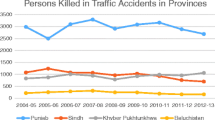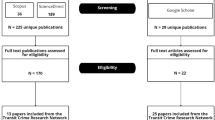Abstract
Subway systems are key components in mass transportation networks worldwide, providing rapid and affordable transportation to urban communities in 58 different countries. The benefits afforded by subway transit are numerous and mainly derived from the reduction in automobile use, thereby limiting environmental and health hazards associated with exhaust-air emissions. Additionally, by limiting congestion and providing vital transportation links within a city, subways also improve the overall quality of life of urban communities. However, to best maximize the positive impact on the urban environment, subway systems need to provide a safe and healthy environment for both passengers and subway transit workers. Periodically, safety concerns are raised, most recently in relation to the vulnerability of subways to terrorist attacks. To examine this issue more carefully, we conducted a structured review of the literature to identify and characterize potential health and safety hazards associated with subways. A secondary goal was to identify various risk management strategies designed to minimize the risk of these hazards. This information may be helpful to urban communities, urban planners, public health specialists, and others interested in subway safety.
Similar content being viewed by others
References
Rail Definitions. American Public Transportation Association (APTA). Web site. Available at: http://www.apta.com/research/stats/rail/definitions.cfm. Accessed November 2004.
Underground Railroads, Infoplease. Available at: http://www.infoplease.com/spot/ subway 1.html. Accessed November 2004.
U.S. Heavy Rail Transit System Links. APTA. Available at: http://apta.com/links/ transit_by_mode/heavyrail.cfm. Accessed November 2003.
A World of Trams and Urban Transit. LRTA. Available at: http://www.lrta.org/worl/worldind.html. Accessed November 2004.
World’s Largest Subway Systems. Jane’s Urban Transport Systems. 2002–2003 ed. Available at: http://www.infoplease.com/ipa/a0762446.html. Accessed November 2004.
The MTA Network. Metropolitan Transit Authority. Available at: http:// www.mta.nyc.ny.us/mta/network.htm. Accessed November 2004.
U.S. Department of Transportation, Bureau of Transportation Statistics. National Transportation Statistics 2003. Fuel Consumption by Mode of Transportation, Washington, DC. Available at. http://www.bts.gov/publications/national_trasnporatation_staitsics/2003/html. Accessed November 2004.
Safety Summary by Mode, 2001. APTA. Available at: http://www.apta.com/research/ stats/safety/safesumm.cfm. Accessed November 2003.
Patron Non-suicide Vehicle-Related Safety Fatalities by Mode. Available at: http:// www.apta.com/research/stats/safety/safefatv.cfm. Accessed November 2004.
National Safety Council. Injury Facts. 2003 ed. Itrasca, IL: National Safety Council.
U.S. Department of Transportation Statistics, Bureau of Transportation Statistics, National Transportation Statistics, 2003.
Transportation-Related Fatalities. APTA. Available at: http://www.apta.com/research/ info/online/rail_transit.cfm. Accessed November 2004.
Fatality Rates by Mode of Travel, 1998–2000. APTA. Available at: http:// www.apta.com/research/stats/safety/natsafe.cfm. Accessed November 2004.
Incident Rates of Non-Fatal Occupational Injuries and illnesses by Industry Type and Case Types, 2002. Department of Labor, Bureau of Labor Statistics. Available at: http:// www.bls.gov/iif/oshwc/osh/os/ostb1244pdf. Accessed July 2004.
Safety Summary by Mode, 2001. APTA. Fatalities, by Mode, 2002, APTA. Available at: http://www.apta.com/research/stats/safety/safesumm.cfm. Accessed November 2004.
Violent Security Incidents by Mode, 1997–2001. APTA. Available at: http:// www.apta.com/research/stats/safety/securvio.cfm. Accessed November 2004.
Transit Safety and Security Statistics and Analysis Annual Report, 1990–2000. Federal Transit Administration, Safety and Security. Available at: http://transit-safety.volpe.dot.gov/ Data/samis/default.asp? ReportID=3. Accessed November 2004.
Selected Personal and property Crimes, 2002. Available at: http://www.ojp.usdoj.gov/ bjs/pub/pdf/cvus0204.pdf. Accessed November 2004.
NYC Transportation. NYC Transit. Available at: http://www.nyc.gov/html/transportataion/ transit-index.html. Accessed November 2004.
Martell DA, Morrison D. Public Perceptions of the Mentally Ill and Danger in the Subways: A Representation Survey of Manhattan Subway Riders. Orangeburg, NY: Nathan S. Kline Institute for Psychiatric Research, New York State Office of Mental Health; 1992. Field Study Technical Paper: 92-01.
Martell DA, Dietz PE, Mentally disordered offenders who push or attempt to push victims onto subway tracks in New York City. Arch Gen Psychiatry. 1992;49:472–475.
Mishara BL. Suicide in the Montreal subway system: characteristics of the victims, antecedents, and implications for prevention. Can J Psychiatry. 1999;44:690–696.
O’Donnell I, Farmer RD. The epidemiology of suicide on the London underground. Soc Sci Med. 1994;38:409–418.
Sonneck G, Etzesdorfer E, Nagel-Kuess S. Immative suicide on the Viennese subway. Soc Sci Med. 1994;38:4523–4527.
Nelson KR. Policing mass transit: serving a unique community. Law Enforcement Bull. 1997;1:1–8.
Smith MJ. Gathering Transit Crime Data: A crime specific approach. Available at: http:// www.rcm-advies.nl/Webpagina’s/Bibliotheek%20-%20OV.htm. Accessed November 2004.
Fecht J. New York mayor in fight against noise pollution. City Mayors Environment. Available at: http://www.citymayors.com/environment/nyc_noise.html. Accessed November 2004.
National Institute for Occupational Safety and Health (NIOSH). Work-related hearing loss. Available at: http://www.cdc.gov/niosh/hpworkrel.html. Accessed August 2002.
Centers for Disease Control. Self-reported hearing loss among workers potentially exposed to industrial noise-United States. MMWR Morb Mortal Wkly Rep. 1988;37:158, 164–167.
Backman AL, Jarvinen E. Turnover of professional drivers. Scand J Work Environ Health. 1983;9:36–41.
Lusk SL, Hagerty BM, Gillespie B, Caruso CC. Chronic effects of workplace noise on blood pressure and heart rate. Arch Environ Health. 2002;57:273–281.
Bhattacharga SK, Aparna R, Tripathi SR, Chatterjee SK. Behavioral measurement in textile weavers wearing ear protectors. Indian J Med Res. 1985;82:56–64.
Melamed S, Luz J, Green MS, Noise exposure, noise annoyance and their elation to psychological distress, accident and sickness among blue collar workers-the Cordis Study. Israel J Med Sci. 1992;28:629–635.
Luck SL, Haggerty BM, Gillespie B, Caruso C. Chronic effects of workplace noise on blood pressure and heart rate. Arch Environ Health. 2002.
Beers MH, Berkow R, eds. The Merck Manual of Diagnosis and Therapy, Ch 85 Sec 7. Available at: http://www.merck.com/pubs/mmanual. Accessed September 2002.
Davis AC, et al. Damage to hearing from leisure noise: A review of the literature. Nottingham, England: MRC Institute of Hearing Research, University of Nottingham; 1985.
Harris CM, Aitken BH, Noise in subway cars. Sound Vibration. 1971; February: 21–24.
Gassaway D. Noise-induced hearing loss. In: McCunney R, ed. A Practical Approach to Occupational and Environmental Medicine. 7th ed. Boston, MA: Little Brown; 1994:230–247.
Kryter KD. Hearing loss from gun and railroad noise—relations with ISO standard 1999. J Acoust Soc Am. 1991;90:180–195.
Occupational Safety and Health Administration (OSHA). Occupational safety and health standards, national consensus standards and established federal standards. Federal Register, U.S. Department of Labor, Occupational Safety and Health. 1971;46:4078–4179.
Occupational Safety and Health Administration (OSHA) 1981. OSHA Technical Manual, Section III, Ch 5. Available at: http://www.osha.gov/dts/osta/otm/otm_iii/otm_iii_5.html. Accessed September 2002.
Johanning E, Fischer S, Christ E, Gores B, Landsbergis P. Whole-body vibration exposure study in U.S. railroad locomotives—An ergonomic risk assessment. AIHAJ. 2002;63:439–446.
Guidotti TL, Cottle MKW. Occupational health problems among transit workers. Public Health Rev. 1987;15:29–44.
Chillrud SN, Esptein D, Ross JM, et al. Elevated airborne exposures of teenagers to manganese, chromium, and iron from steel dust and New York City’s subway system. Environ Sci Technol. 2004:38:732–737.
Yu IJ, Yoo CY, Chung YH, et al. Asbestos exposure among Seoul metropolitan subway workers during renovation of subway air-conditioning systems. Environ Int. 2004;29:931–934.
Krause N, Ragland DR, Fisher JM, Syme SL. Volvo award winner in clinical studies: psychosocial job factors, physical workload, and incidence of work-related spinal injury: a 5-year prospective study of urban transit operators. Spine. 1998;23:2507–2516.
Chillrud S. Steel dust in the New York City subway system as a source of manganese, chromium and iron exposures for transit workers. J Urban Health. 2005;82:33–42.
Aarnio P, Kousa A, Yli-Tuomi T, Jantunen M, Koskentalo T. Composition of and exposure to PM2.5 while commuting in the metro and on the street. Presented at: Strategies for Clean Air and Health; November 5–7, 2003; Rome, Italy.
Pellizzari ED, Mason RE, Clayton CA, et al. Manganese Exposure Study (Toronto). Final Report. Research Triangle Institute, June 30, 1998. RTI/6312/02-01 F.
Boudia N, Halley R, Kennedy G, Gareau L, Zayed J. Manganese concentrations in the air of the Montreal (Canada) subway in relation to surface automobile traffic density. Toxicologist. 2004;78(S-1):80.
Ching J. Control of Communicable Disease Manual. Washington, DC: APHA; 2000.
Dietrich FM, Jacobs WL. Survey and Assessment of Electric and Magnetic Field (EMF) Public Exposure in the Transportation Environment. U.S. Department of Transportation, Federal Railroad Administration; 1999. Report No. PB99-130908.
Pearson H. Mobile-phone radiation damages lab DNA. Available at: http:// www.nature.com/news/2004/041220/full/041220-6.html. Accessed December 22, 2004.
Muc AM. Electromagnetic fields associated with transportation systems. Available at: http://www.rhsc.ca/TransEMF.pdf. Accessed December 22, 2004.
Okumura T, Takasu N, Ishimatsu S, et al. Report on 640 victims of the Tokyo subway sarin attack. Ann Emerg Med. 1996;28:129–135.
American Public Transportation Association. Checklists for Emergency Response Planning and System Security. Available at: http://www.apta.com/services/safety/checklist.cfm. Accessed November 2004.
Federal Transit Administration. Safety and Security. Available at: http://transit-safety. volpe.dot.gov. Accessed November 2004.
Author information
Authors and Affiliations
Corresponding author
Rights and permissions
About this article
Cite this article
Gershon, R.R.M., Qureshi, K.A., Barrera, M.A. et al. Health and safety hazards associated with subways: A review. J Urban Health 82, 10–20 (2005). https://doi.org/10.1093/jurban/jti004
Accepted:
Issue Date:
DOI: https://doi.org/10.1093/jurban/jti004




